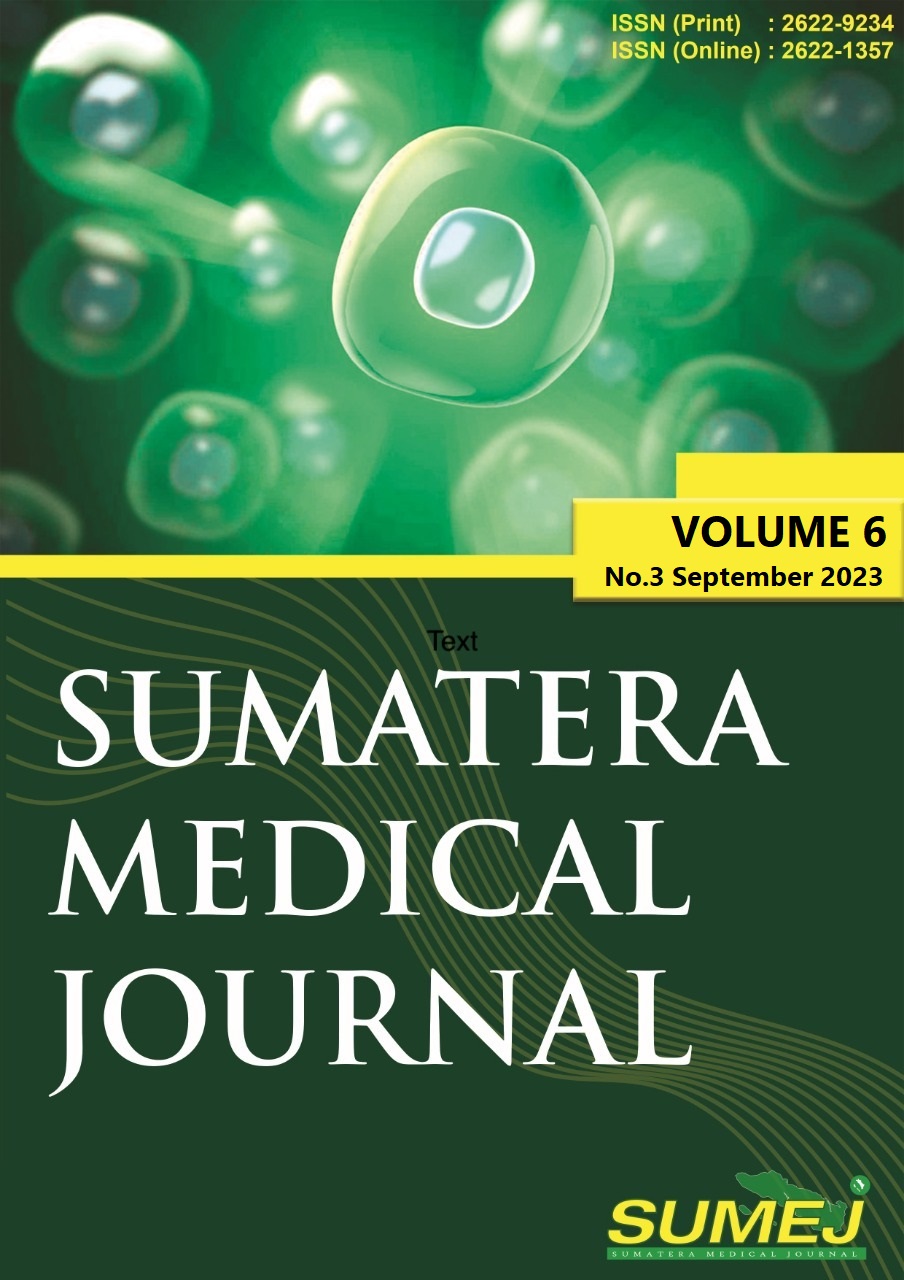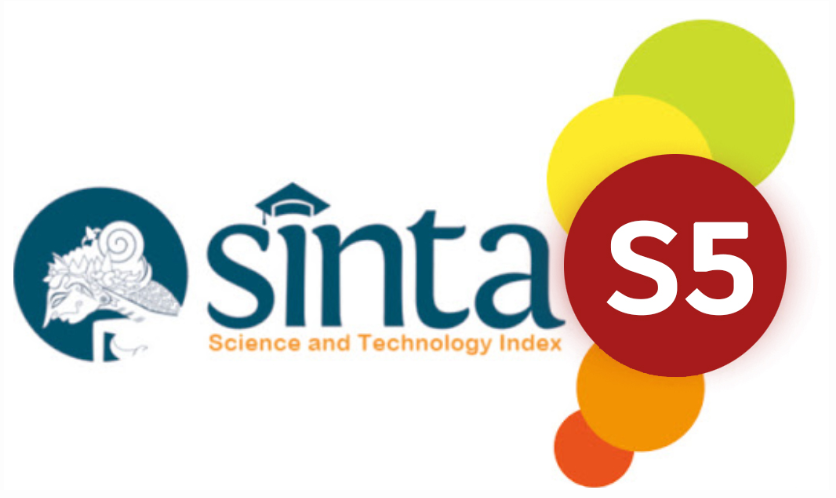Relationship Between the Practice of Consuming Pork Lawar and the Prevalence of Taeniasis in Kerobokan Village, Badung Regency, Bali
DOI:
https://doi.org/10.32734/sumej.v6i3.11012Keywords:
pork lawar, taenia saginata, taenia solium, taeniasisAbstract
Background: Taeniasis is an infection brought on by Taenia sp. Tapeworms, one of which is Taenia solium, whose intermediate host is swine. Adult tapeworms develop in the intestines of the host (human) after consuming infected pork that was not properly prepared. Objective: To determine the relationship between the consumption of pork lawar and the incidence of taeniasis in the village of Kerobokan, Badung Regency, Bali. Methods: This is a correlative categorical research with a cross sectional design. The study population is people in Kerobokan Village, Bali Province. Using power of 0.8 strength of linear correlation of 0.25, and additional 10% for incomplete data, we obtain sample size of 128 people who meet inclusion criteria. Data was obtained by filling out a set of validated questionnaire. Results: Sixty-five out of 128 respondents (50.8%) were found to possess a positive inclination towards the consumption of pork lawar, and only 1 (one) respondent (0.08%) had a history of taeniasis. The significance value of the correlation (p) between the habit of eating pork lawar and a history of taeniasis was 0.312. Conclusion: There is a lack of correlation between the practise of consuming pork lawar and the prevalence of taeniasis among the population.
Downloads
References
Coral-Almeida M, Gabriel S, Abatih EN, Praet N, Benitez W, Dorny P. Taenia solium human cysticercosis: a systematic review of sero-epidemiological data from endemic zones around the world. Natl Libr Med. 2015.
World Health Organization. Taeniasis/cysticercosis: Fact Sheet. 2022. Available from: https://www.who.int/news-room/fact-sheets/detail/taeniasis-cysticercosis. Accessed March 15, 2022.
Okello AL, Thomas LF. Human taeniasis: current insights into prevention and management strategies in endemic countries. Int J Gen Med. 2017;10:107–16. Available from: https://doi.org/10.2147/IJGM.S106614.
Torgerson PR, Devleesschauwer B, Praet N, Speybroeck N, Willingham AL, Kasuga F, et al. World Health Organization estimates of the global and regional disease burden of 11 foodborne parasitic diseases, 2010: a data synthesis. PLoS Med. 2015;12(12):e1001920. Available from: https://doi.org/10.1371/journal.pmed.1001920.
Wandra T, Depary AA, Sutisna P, Margono SS, Suroso T, Okamoto M, et al. Taeniasis and cysticercosis in Bali and North Sumatra, Indonesia. Parasitol Int. 2006;55:S155–60. Available from: https://doi.org/10.1016/j.parint.2005.11.024.
Gutama L, Salim A, Jaya N, Suyasa I, Devinta M, Wahyuniari I. Red Worm Free Program for Ada Village Communities. Serving Udayana Bulletin. 2021;20.
Trisdayanti NPE, Sawitri AAS, Sujaya IN. Sanitation hygiene and the potential presence of E. coli virulence genes in Lawar in Kuta: challenges of tourism and food health in Bali. Public Health Prev Med Arch. 2015;3:99–105.
Bekti HS, Habibah N, Rinawat LP, Yasa NPCD, Rindi ODG, Dewi NKAK, Savitri NPAD, Rakhmawati A. Microscopic identification of Taenia solium in pig farming. Health J. 2021;12.
Susanty E. Taeniasis solium and sistisercosis in human. J Ilmu Kedokteran. 2019;12:1–6.
Wandra T, Margono SS, Gafar MS, Saragih JM, Sutisna P, Sudewi AR, et al. Current situation of taeniasis and cysticercosis in Indonesia. Trop Med Health. 2007;35:323–8.
Barus LG. Relationship of Taenia solium infection to pork consumption in Simalingkar B area. Medan: University of North Sumatra; 2021.
Wilson M, Sarti E, Roberts J, Gutierrez IO, Schantz PM, Flisser A, et al. Prevalence and risk factors for Taenia solium taeniasis and cysticercosis in humans and pigs in a village in Morelos, Mexico. Am J Trop Med Hyg. 1992;46:677–85.
Watts NS, Pajuelo M, Clark T, Loader MCI, Verastegui MR, Sterling C, et al. Taenia solium infection in Peru: a collaboration between Peace Corps volunteers and researchers in a community-based study. PLoS One. 2014;9(7):e101709. Available from: https://doi.org/10.1371/journal.pone.0101709.
Simatupang CV. Description of the state of Taenia solium in the Pardomuan Nauli community, Selayang Village, Finish District, Langkat Regency. Medan: Republic of Indonesia Ministry of Health, Medan Health Polytechnic; 2019.
Downloads
Published
How to Cite
Issue
Section
License
Copyright (c) 2023 Sumatera Medical Journal

This work is licensed under a Creative Commons Attribution-NonCommercial-NoDerivatives 4.0 International License.
The Authors submitting a manuscript do so on the understanding that if accepted for publication, copyright of the article shall be assigned to Sumatera Medical Journal (SUMEJ) and Faculty of Medicine as well as TALENTA Publisher Universitas Sumatera Utara as publisher of the journal.
Copyright encompasses exclusive rights to reproduce and deliver the article in all form and media. The reproduction of any part of this journal, its storage in databases and its transmission by any form or media, will be allowed only with a written permission from Sumatera Medical Journal (SUMEJ).
The Copyright Transfer Form can be downloaded here.
The copyright form should be signed originally and sent to the Editorial Office in the form of original mail or scanned document.











